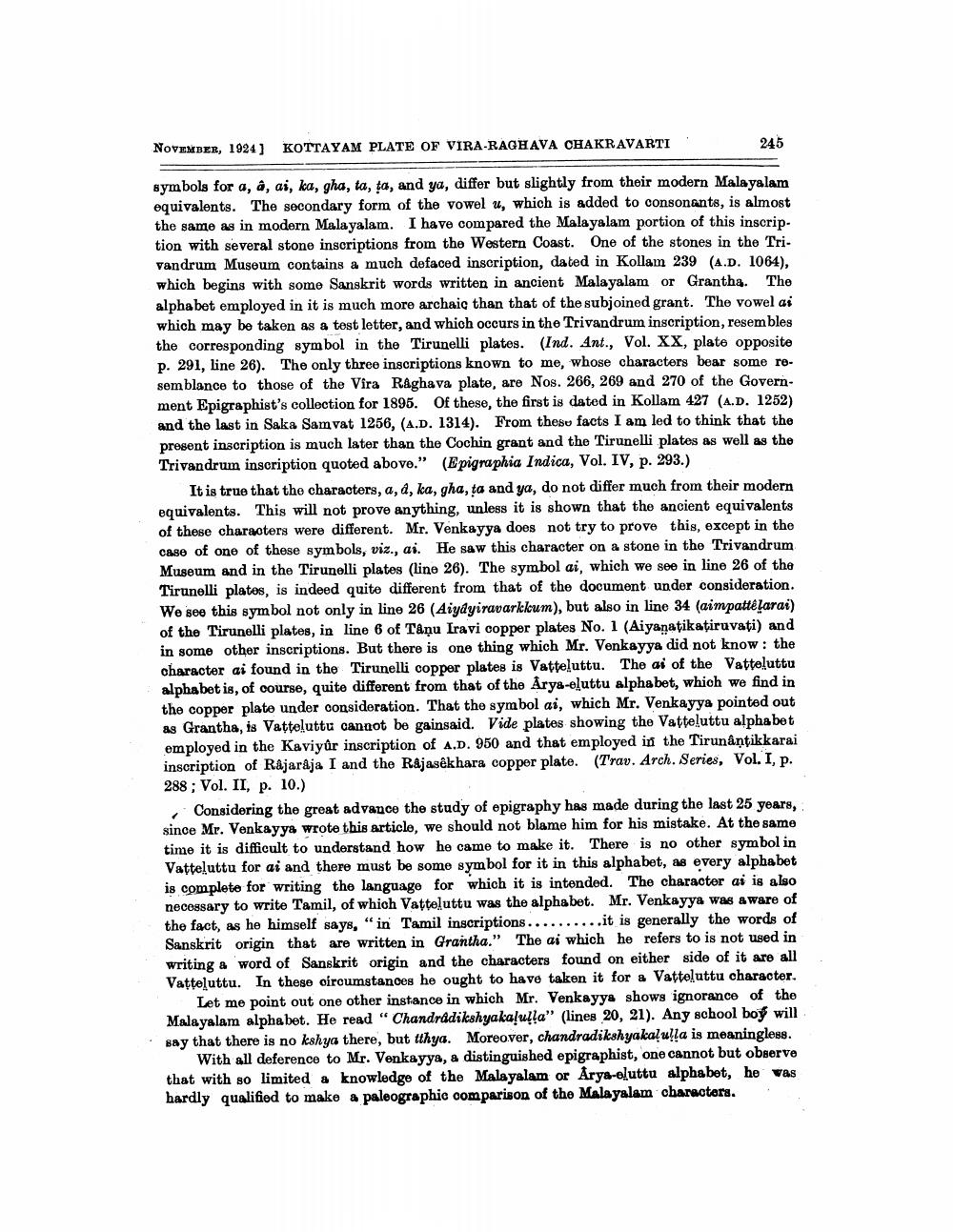________________
NOVEMBER, 1924) KOTTAYAM PLATE OF VIRA-RAGHAVA CHAKRAVARTI !
245
symbols for a, a, ai, ka, gha, ta, ta, and ya, differ but slightly from their modern Malayalam equivalents. The secondary form of the vowel u, which is added to consonants, is almost the same as in modern Malayalam. I have compared the Malayalam portion of this inscrip. tion with several stone inscriptions from the Western Coast. One of the stones in the Tri. vandrum Musoum contains a much defaced inscription, dated in Kollam 239 (A.D. 1064). which begins with some Sanskrit words written in ancient Malayalam or Grantha. The alphabet employed in it is much more archaic than that of the subjoined grant. The vowel ai which may be taken as a test letter, and which occurs in the Trivandrum inscription, resembles the corresponding symbol in the Tirunelli plates. (Ind. Ant., Vol. XX, plate opposite p. 291, line 26). The only three inscriptions known to me, whose characters bear some resemblance to those of the Vira Raghava plate, are Nos. 266, 269 and 270 of the Government Epigraphist's collection for 1895. Of these, the first is dated in Kollam 427 (A.D. 1252) and the last in Saka Samvat 1256, (A.D. 1314). From these facts I am led to think that the present inscription is much later than the Cochin grant and the Tirunelli plates as well as the Trivandrum inscription quoted above." (Epigraphia Indica, Vol. IV, p. 293.)
It is true that the characters, a, a, ka, gha, ta and ya, do not differ much from their modern equivalents. This will not prove anything, unless it is shown that the ancient equivalents of these characters were different. Mr. Venkayya does not try to prove this, except in the case of one of these symbols, viz., ai. He saw this character on a stone in the Trivandrum Museum and in the Tirunelli plates (line 26). The symbol ai, which we see in line 26 of the Tirunelli platos, is indeed quite different from that of the document under consideration. We see this symbol not only in line 26 (Aiydyiravarkkum), but also in line 34 (aimpattēļarai) of the Tirunelli plates, in line 6 of Tanu Iravi copper plates No. 1 (Aiyanatikatiruvati) and in some other inscriptions. But there is one thing which Mr. Vonkayya did not know: the character ai found in the Tirunelli copper plates is Vatteluttu. The ai of the Vatteluttu alphabet is, of course, quito different from that of the Arya-eluttu alphabet, which we find in the copper plate under consideration. That the symbol ai, which Mr. Venkayya pointed out as Grantha, is Vatteluttu cannot be gainsaid. Vide plates showing the Vatteluttu alphabet employed in the Kaviyûr inscription of A.D. 950 and that employed in the Tirunânţikkarai inscription of Rajaraja I and the Rajasekhara copper plate. (Trav. Arch. Series, Vol. I, p. 288; Vol. II, p. 10.)
Considering the great advance the study of epigraphy has made during the last 25 years, since Mr. Venkayys wrote this article, we should not blame him for his mistake. At the same time it is difficult to understand how he came to make it. There is no other symbol in Vatteluttu for ai and there must be some symbol for it in this alphabet, as every alphabet is complete for writing the language for which it is intended. The character ai is also necessary to write Tamil, of which Vatteluttu was the alphabet. Mr. Venkayya was aware of the fact, as he himself says, “in Tamil inscriptions ..........it is generally the words of Sanskrit origin that are written in Grantha." The ai which he refers to is not used in writing a word of Sanskrit origin and the characters found on either side of it are all Vatteluttu. In these circumstances he ought to have taken it for a Vatteluttu character.
Let me point out one other instance in which Mr. Venkayya shows ignorance of the Malayalam alphabet. He read "Chandradikshyakalulla" (lines 20, 21). Any school boy will say that there is no kshya there, but tthya. Moreover, chandradikshyakaļ ulla is meaningless.
With all deference to Mr. Venkayya, a distinguished epigraphist, one cannot but observe that with so limited a knowledge of the Malayalam or Arya-eluttu alphabet, he vas hardly qualified to make a paleographic comparison of the Malayalam characters.




